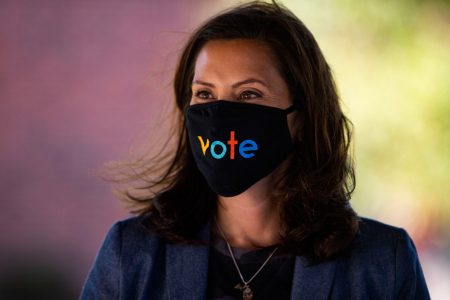Trump and the Plot Against Michigan Governor Gretchen Whitmer

Michigan Gov. Gretchen Whitmer wears a mask with the word “vote” displayed on the front during a roundtable discussion on healthcare, Wednesday Oct. 7, 2020, in Kalamazoo, Mich. (Nicole Hester/Ann Arbor News via AP)
October 12, 2020
13 men connected to an attempted plot to kidnap Michigan Governor Gretchen Whitmer were arrested by FBI agents on Oct. 8. The men were charged with terrorism and conspiracy after a plot to kidnap the Democratic governor was discovered by investigating FBI agents.
The plan to kidnap Governor Whitmer was discussed in an encrypted group chat by the men, who were upset with Governor Whitmer’s attempt to stop the spread of the coronavirus. The governor shut businesses down, which infuriated many. The men, who believed Governor Whitmer was violating the Constitution, spied on her and planned to kidnap her, before holding a “trial” for her crimes. The men had also planned to blow up a bridge as a distraction during the kidnapping. Evidence of their plans was found by FBI agents, who found that the men had been planning on purchasing explosives.
The men charged by the federal government were found to be members of far-right extremist groups and the boogaloo movement, a loosely organized anarchist group. Members of the movement have conflicting views, as some extol white supremacy, while others do not. Some of the men called investigations into the 2016 election an “uprising” against President Trump, and their actions were spurred by President Trump’s words.
Earlier this year, Trump had insulted Governor Whitmer over Twitter, saying she had done “a terrible job,” as well as saying “Liberate Michigan,” presumably from Governor Whitmer. After the arrests were made, Trump tweeted that Whitmer was ungrateful and should’ve thanked him for the arrests.
However, to many, President Trump’s response to this incident has been rather minimal and lacking. This is further accentuated by his actions during the presidential debate, where he failed to condemn white supremacist groups, and instead told the far-right to “stand back and stand by,” which gave the groups the acknowledgement they wanted. After adopting the phrase “law and order,” Trump has been mostly silent about the terrorist plot against Governor Whitmer.
Many have contrasted this response with his response to the protesters protesting the death of George Floyd, when he adopted the “law and order” mantle. During the protests, Trump condemned the protesters as rioters and looters. He also sent the National Guard to several states to suppress protesters they deemed violent. President Trump’s actions during that time bolstered his popularity among his supporters. President Trump uses the “law and order” stance when it directly benefits him, and doesn’t use it otherwise.
“The White House wanted to cover its eyes and wanted to cover its ears when it heard about domestic terrorism because they didn’t want to pay attention to the right-wing extremists that they saw as a potential base of support,” said Miles Taylor, a former Homeland Security official.”
As a consequence, the president’s rhetoric has served as a loaded gun for those groups who have since taken his words as sort of permission to do what they’re doing.”
Photo courtesy of ROLLINGSTONE.COM
